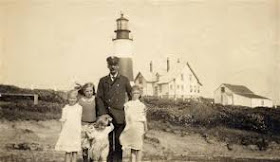 |
| A Lighthousekeeper and his family |
Lighthousekeeping was no sinecure. Keepers fulfilled a vital
role and carried a heavy responsibility for maintaining the light. Every aspect of their duties was covered by
the printed Rules and Regulations of which every keeper received a copy. It
would be his ‘bible’ for the entire period of his service.
‘Rules for the Proper Care and Maintenance of the Light on
the Bluff at Port Natal’ would have been my ancestor Thomas Gadsden’s daily
reading, in-between all his other activities. The Rules were published in each
annual edition of the Natal Almanac and Yearly Register and changed little from
their inception to the phase after Thomas’s death.
The following instructions give some idea of a keeper’s many
and varied tasks:
Great care is to be bestowed in keeping everything connected
with the Lighthouse in a thorough state of cleanliness and efficiency, as the
optical apparatus, consisting of lenses and prisms, suffers materially from the
effect of dust injuring its polish, and as the proper burning of the lamp is
impaired by a want of due attention to its cleanliness and the state of the
works.
 |
| Fresnel lens close-up |
The glass lenses and prisms are to be cleaned every day,
being first freed from dust by a feather or other soft brush and then rubbed
down with a soft chamois skin, free from anything that would injure the polish
of the glass. If the glass becomes greasy it is to be first washed with a linen
cloth steeped in spirits of wine and afterwards carefully dried with a soft dry
linen cloth or rubber free from all dust and gritty particles and finally
rubbed with a fine chamois leather.
The brass work of the lamps is to be kept clean by polishing
with whitening or suitable polishing
paste. Great care is to be taken that the lamp is accurately in the focus of
the illuminating apparatus and that the flow of oil is such that a proper
height of flame is maintained. If the flame cannot be maintained to its proper
height, the lightkeeper must immediately examine whether or not it is due to
want of cleanliness of the burner, want of proper flow of oil, or any
imperfection in the wicks or oil, or the draught of the lamp’s chimney. The
wicks should be gradually raised during the first 20 minutes of burning until
the flame reaches the proper height to give the maximum amount of light.
Note: the mechanical lamps being constructed to give a
plentiful overflow from 3-4 times the quantity consumed, the wicks char but
slowly. The lamp should burn, when in good order, the whole night without the
works requiring to be touched when paraffin oil is used. [Paraffin came into use about mid-19th century]
All moving parts in the revolving machinery and mechanical
lamps must be kept scrupulously clean. Ventilator to be opened to admit sufficient supply of air to
ensure proper burning of the light and
prevent condensation. Storm frames are to be kept in readiness for immediate use
in case of accident.
The windows of the lantern are to be regularly cleansed
every day and washed with water when necessary to remove the sea spray or other
obstructions to the passage of the light, and for the same reason they are to
be rubbed during the night when they become obscured by condensation or
sweating.
http://video.nationalgeographic.com/video/short-film-showcase/a-day-in-the-life-of-a-lighthouse-keeper
http://video.nationalgeographic.com/video/short-film-showcase/a-day-in-the-life-of-a-lighthouse-keeper
To be continued ...


Fascinating. One realises that keepers had their hands full, and weren't always watching out to sea for burning steamers. Thanks, Andrew.
ReplyDelete